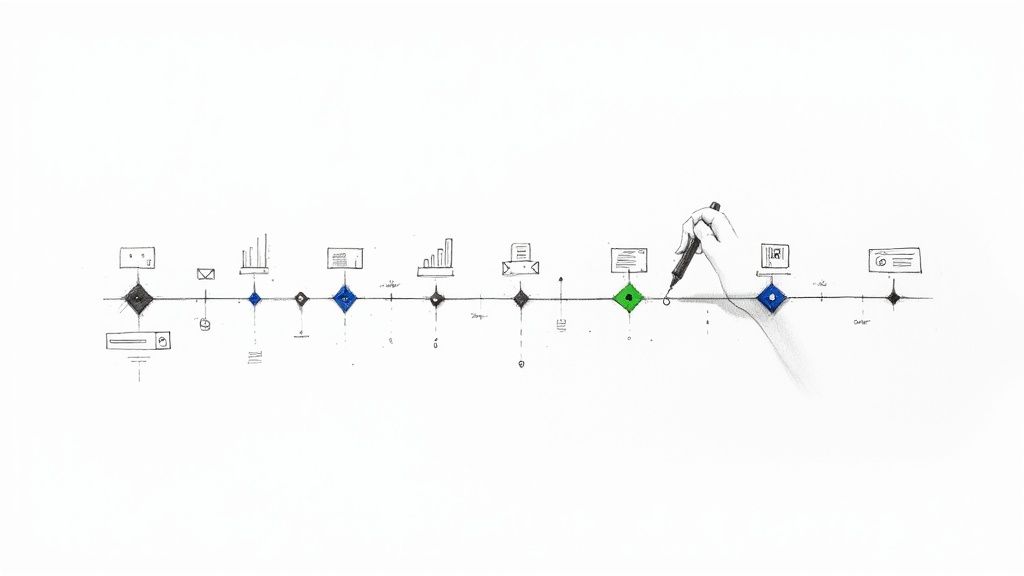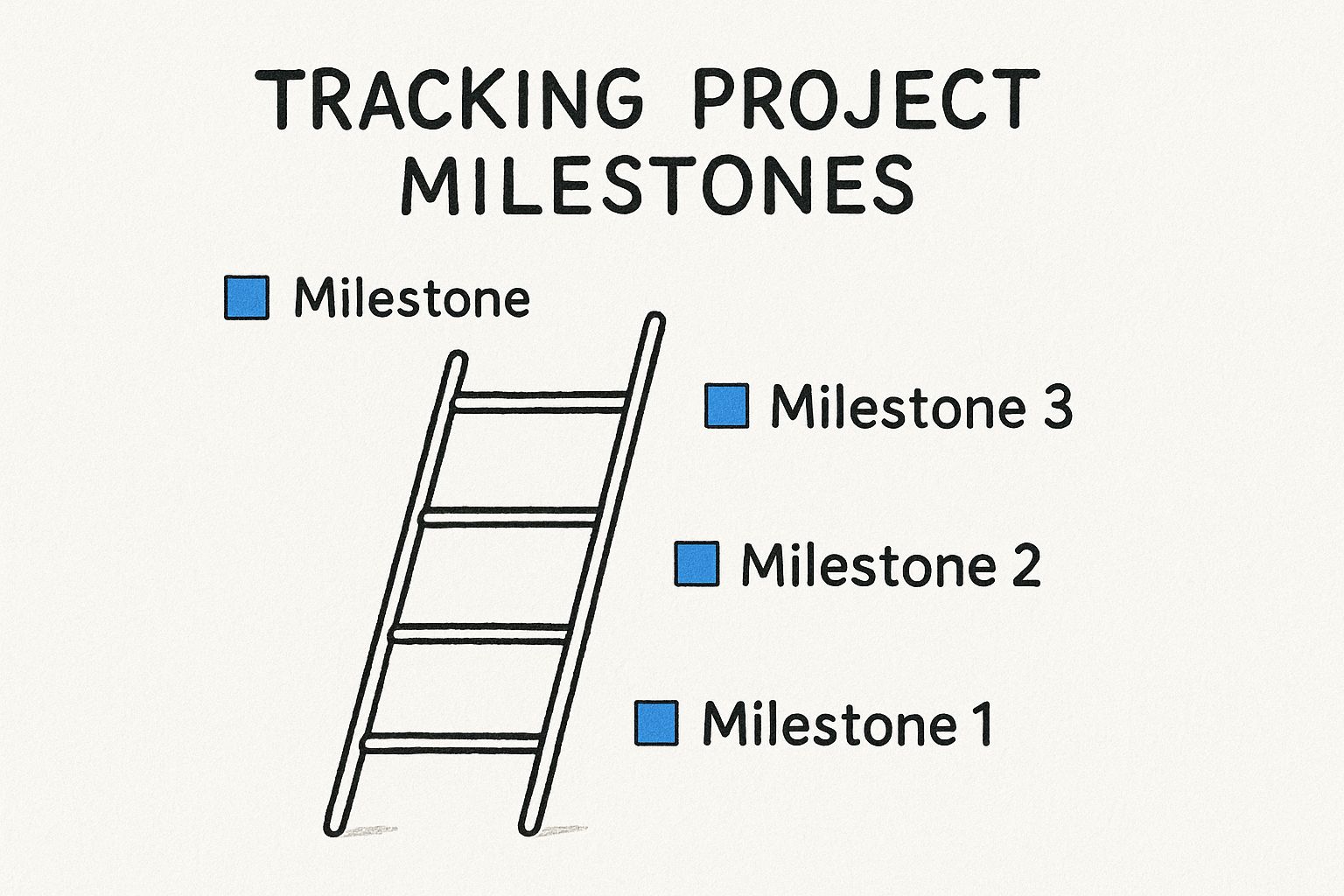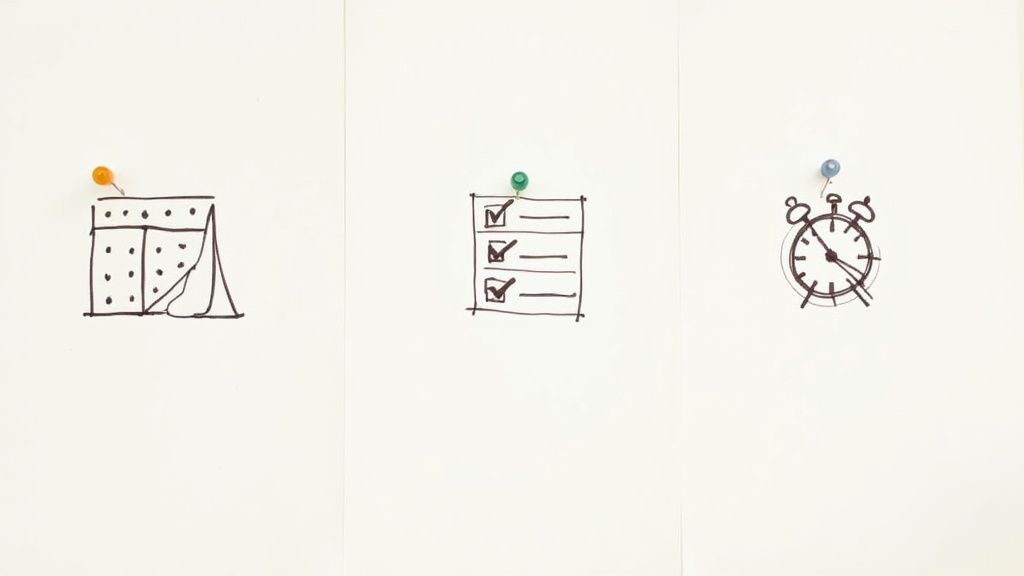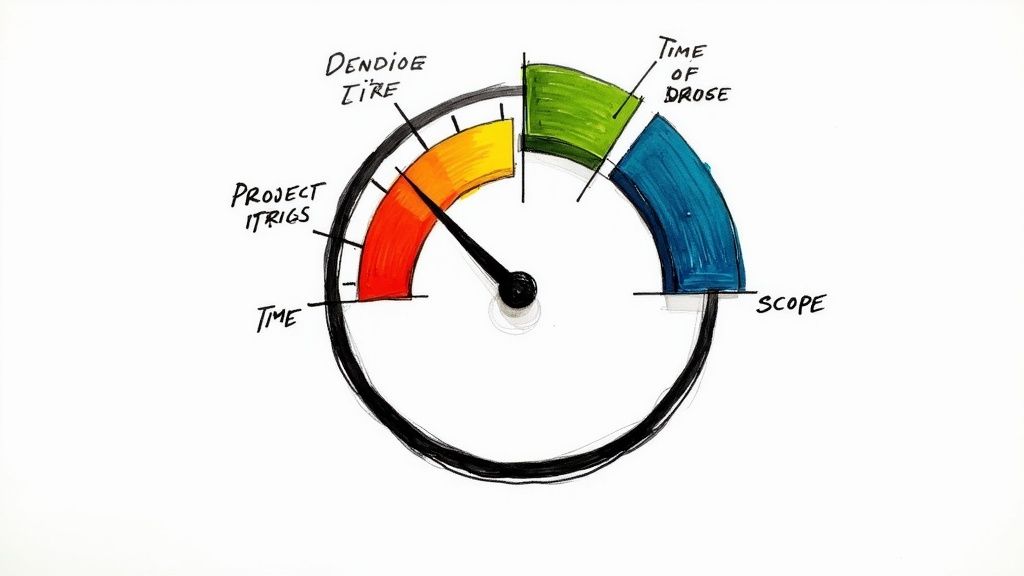
Track Project Progress: 10 Strategies for Success
Learn how to track project progress effectively with proven strategies. Boost team performance and deliver results with expert techniques.

Why Tracking Project Progress Transforms Results
Tracking project progress is more than just a routine task; it's the driving force behind successful projects. Think of it as your GPS, guiding you towards your objective and alerting you to potential obstacles. Without it, projects can easily go astray, exceeding budgets, missing deadlines, and ultimately failing to deliver the expected value. Understanding the importance of progress tracking is just as crucial as knowing how to do it.
The Impact of Effective Tracking
Imagine constructing a building without blueprints or inspecting the foundation before framing. The consequences could be disastrous. Likewise, projects lacking robust tracking are susceptible to a multitude of problems. Effective progress monitoring helps prevent scope creep, where projects expand beyond their initial boundaries, frequently resulting in cost overruns and delays.
It also enables you to identify bottlenecks early, allowing for prompt interventions and course correction. For example, if a crucial task is falling behind schedule, you can reallocate resources or adjust dependencies to lessen the impact. Finally, and perhaps most importantly, tracking ensures alignment with strategic goals. By continually monitoring progress against key performance indicators (KPIs), you can ensure the project remains focused on delivering the desired business outcomes.
The Business Case for Tracking
Tracking project progress is fundamentally linked to financial performance and overall organizational success. This connection is becoming ever more critical as the demand for project management expertise continues to rise. In fact, the global demand for project talent is projected to increase by 64% over the next ten years, with the need for project management professionals estimated to reach 25 million by 2030. Effective progress tracking has become a strategic imperative, with 80% of project managers recognizing that project portfolio management—which encompasses tracking and aligning multiple projects with business objectives—is essential for business success. Explore this topic further
Real-Time Monitoring and the Triple Constraints
Real-time monitoring is essential for managing the triple constraints of time, cost, and quality. Having immediate visibility into project performance allows you to quickly identify deviations from the plan and take corrective action. This proactive strategy minimizes the chances of projects veering uncontrollably off track.
Moreover, real-time data allows you to make well-informed decisions about resource allocation, risk mitigation, and stakeholder communication. This proactive management style directly affects profitability by reducing rework, avoiding expensive delays, and ensuring the final deliverable meets the required quality standards. A robust, data-driven tracking system establishes the groundwork for predictable project outcomes and empowers teams to deliver exceptional results.
Implementing Effective Tracking Systems
Successfully implementing a project tracking system depends on selecting the right tools and encouraging team adoption. This involves choosing software that aligns with your project methodology and team preferences, as well as offering adequate training and support. For Google Workspace users, Tooling Studio provides lightweight Chrome extensions like Kanban Tasks to improve productivity and enable streamlined project tracking directly within Gmail and Google Tasks.
Effective progress tracking isn't simply about checking off tasks; it's about cultivating a culture of accountability, transparency, and continuous improvement. This empowers teams not only to achieve project goals but also to learn from each project and enhance organizational performance over time.
To further illustrate the benefits of effective progress tracking, let's examine the following table:
Impact of Effective Progress Tracking on Project Outcomes
This table demonstrates the measurable benefits organizations experience when implementing structured project progress tracking systems versus ad-hoc approaches.
| Key Performance Indicator | Without Structured Tracking | With Structured Tracking | Improvement |
|---|---|---|---|
| On-Time Project Completion | 40% | 75% | 35% |
| Budget Adherence | 50% | 85% | 35% |
| Stakeholder Satisfaction | 60% | 90% | 30% |
| Team Productivity | 65% | 95% | 30% |
The table clearly shows a significant improvement across all key performance indicators when structured project progress tracking is implemented. From on-time project completion to stakeholder satisfaction, the data highlights the substantial positive impact of a well-defined tracking system. By adopting such systems, organizations can unlock greater efficiency, predictability, and overall project success.
Essential Metrics That Actually Predict Project Success
Forget vanity metrics; it's time to focus on measurements that truly matter. Analyzing successful projects reveals crucial indicators of positive outcomes across various industries. These indicators help maintain a complete picture of project health. For a deeper dive into project tracking metrics, check out this helpful resource: How to master project-tracking metrics. This knowledge empowers you to identify potential problems before they derail your project.
Balancing Quantitative and Qualitative Measurement
Tracking project progress requires a balanced approach, combining quantifiable data with qualitative insights. Quantitative measures, such as schedule variance, cost performance index, and earned value, provide objective assessments of project performance against the baseline. For example, schedule variance calculates the difference between planned and actual completion dates. This tells us whether the project is ahead of or behind schedule.
However, numbers don't tell the whole story. Qualitative indicators, like team satisfaction and stakeholder feedback, offer valuable context about project dynamics. Low team morale, even if the project is on schedule and within budget, could indicate future issues, such as burnout or decreased productivity.
Combining these approaches provides a more holistic understanding of project health. This perspective lets project managers make informed decisions, considering not just the numbers but also the human element. This is particularly valuable in complex projects with many moving parts and potential unforeseen challenges.
To illustrate how teams can effectively track progress, let's examine some key project progress metrics by phase. The following table outlines critical metrics, their calculation methods, target ranges, and potential warning signs.
| Project Phase | Key Metrics | Calculation Method | Target Range | Warning Signs |
|---|---|---|---|---|
| Initiation | Stakeholder Alignment | Surveys, Interviews | >90% agreement on objectives | Conflicting priorities, lack of clear vision |
| Planning | Schedule Baseline Accuracy | Estimated duration vs. historical data | <10% deviation | Unrealistic deadlines, insufficient resource allocation |
| Execution | Earned Value (EV) | % of completed work x budgeted cost | On or above planned value | Cost overruns, schedule slippage |
| Monitoring & Controlling | Cost Performance Index (CPI) | EV / Actual Cost (AC) | ≥ 1.0 | Budget exceeding earned value |
| Closure | Customer Satisfaction | Post-project surveys | > 4 out of 5 rating | Negative feedback, unmet expectations |
This table helps project managers quickly identify which metrics are most relevant during each phase and what ranges to aim for. Recognizing warning signs early on can prevent small issues from escalating into major problems.

The infographic above visualizes project progress using milestones represented as ascending steps. Each step signifies a completed phase, showing the incremental nature of achieving project goals. This visual reinforces the value of breaking down large projects into smaller, more manageable milestones.
Establishing Meaningful Baselines and Measurement Frequency
Effective progress tracking begins with meaningful baselines. These serve as benchmarks against which progress is measured. Baselines should be realistic, achievable, and aligned with project objectives. Accurate baselines are essential for meaningful metrics like schedule variance and cost performance index.
Determining the optimal measurement frequency is also crucial. Too frequent monitoring can be burdensome, while infrequent tracking can lead to delayed problem identification. The ideal frequency depends on project complexity, duration, and risk profile. A high-risk project might benefit from daily tracking, while a longer-term, lower-risk project could be monitored weekly or bi-weekly.
Designing Effective Visual Dashboards
Visual dashboards effectively communicate project status. A well-designed dashboard consolidates key metrics into an easily understood format, providing stakeholders with a clear overview. Dashboards can use charts, graphs, and other visuals, simplifying complex data.
Effective dashboards tailor information to the audience, giving detailed data to technical teams and high-level summaries to executive sponsors. This ensures that all stakeholders receive the information they need in a readily understandable format, fostering better communication and decision-making.
Digital Tools That Transform How You Track Progress

Selecting the right tools can significantly impact a project's outcome. This section explores the world of project management software, helping you discern true value from marketing hype. We'll examine various platforms, from established enterprise solutions to newer, AI-powered options, to determine which tools best suit your project tracking needs.
From Enterprise Giants to Agile Innovators
The project management software market offers a diverse range of platforms, each with its own advantages. Enterprise solutions like Microsoft Project and Jira provide robust features for complex projects. These include detailed Gantt charts, resource management, and advanced reporting. However, these platforms can have a steep learning curve and require substantial training. For a different perspective, consider exploring Google Workspace for project management: How to master Google Workspace project management.
Alternatively, agile-focused tools such as Trello and Asana emphasize flexibility and collaboration. These platforms utilize Kanban boards and visual tools to simplify task management and enhance team communication. This makes them well-suited for dynamic projects requiring frequent adjustments.
The growing demand for efficient project management is evident in the expanding market for project management software. Valued at over $6 billion in 2021, the market is projected to reach $8.19 billion by 2024 and potentially exceed $15 billion by 2030. This rapid growth underscores the vital role of digital tools in tracking project progress. For more detailed statistics, see: https://monday.com/blog/project-management/project-management-statistics/
Features That Truly Enhance Tracking
Not all features contribute equally to efficient project tracking. Features like automated notifications and real-time reporting offer immediate insights into project status, allowing quick responses to emerging issues. For example, automated notifications can alert project managers to task delays or budget overruns.
However, some features can be counterproductive. Overly complex customization options or an excessive number of integrations can lead to decision paralysis and wasted time. Focus on identifying features that directly support your project's specific requirements and workflow, ensuring they add value rather than complexity.
Seamless Integration and Mobile Accessibility
Choosing a tool that integrates smoothly with your existing systems is crucial. This minimizes manual data entry, reduces errors, and streamlines workflows. If your team uses Google Workspace, integrating project management tools with Google Calendar and Google Drive can simplify scheduling and document management.
Mobile accessibility is also essential in today's distributed work environments. Team members need access to project information, the ability to update tasks, and seamless communication with colleagues while on the go. A robust mobile app ensures everyone stays connected and informed, regardless of location.
Driving Tool Adoption and Team Buy-In
Successfully implementing new tools involves more than just selecting the right software. It requires addressing the human factor. Team resistance to new tools, often stemming from a fear of change or perceived complexity, is a common hurdle.
Overcoming this resistance requires a proactive strategy. Provide comprehensive training, address concerns, and showcase the clear advantages of the new tool. This fosters team buy-in and encourages active engagement with the technology.
Mastering Multi-Project Progress Tracking
Managing a single project effectively can be tricky, but overseeing multiple projects at the same time requires a whole different strategy. Successfully juggling numerous projects calls for robust systems and a clear understanding of how to monitor progress across your entire portfolio. This needs to be done without getting lost in the weeds.
Standardized Reporting and Governance
High-performing organizations use standardized reporting frameworks. This allows for valuable comparisons between different projects and reveals insights that wouldn't be obvious when looking at projects individually. Standardization creates consistency, making it simpler to spot trends and potential issues across the portfolio.
Establishing clear governance structures is also essential. These structures ensure that consistent tracking practices are followed across all projects, no matter the individual project manager's preferences. This consistency is key for accurate reporting and effective decision-making at the portfolio level. Imagine trying to assess the health of your portfolio if every project manager uses different reporting methods!
Executive Dashboards and Drill-Down Capabilities
Executive dashboards give a high-level overview of the entire portfolio's progress, offering valuable insights at a glance. These dashboards should have drill-down capabilities, letting stakeholders dive deeper into specific projects for a more detailed analysis if needed. This balance of a broad perspective and granular detail is crucial for smart strategic decisions.
For additional support, consider using Remote Project Management Tools. This resource provides insights into tools that can streamline your processes and improve collaboration, especially in remote or hybrid work environments.
Managing Resources, Dependencies, and Synergies
Effectively tracking multi-project progress requires diligent resource management. This means having systems to identify and resolve resource conflicts between projects. For instance, if two projects need the same specialized skill set simultaneously, a decision must be made about resource allocation and priorities.
Tracking dependencies between projects is also critical. One project's delay can impact the timelines of other dependent projects. Understanding these dependencies is essential for proactive management and mitigating potential delays.
Identifying cross-project synergies is equally vital. This involves finding areas where projects can share resources, knowledge, or deliverables. This can boost efficiency and reduce costs. If several projects require similar research, conducting it once and sharing the findings can save significant time and resources. Project managers often handle multiple initiatives at the same time. In fact, more than 85% of project managers juggle several projects concurrently. This emphasizes the need for robust tracking. Almost 40% of project teams have 6 to 10 members, making progress tracking even more complex. Nearly 10% of every project dollar is wasted because of poor project performance, with ineffective progress tracking as a major factor. For more statistics, see: https://pm360consulting.ie/25-project-management-statistics-to-guide-your-plans-in-2025/
Mastering multi-project progress tracking is essential for organizations aiming for operational excellence. By using standardized reporting, establishing strong governance, and using effective tools, project managers can get a clear, real-time view of their portfolio's health. This allows for proactive decision-making, optimized resource allocation, and successful project delivery contributing to overall organizational goals.
Creating Progress Reports People Actually Read

Let's be honest: many progress reports go unread. This means valuable information is lost and chances to improve are missed. This section explores how to turn tracking data into engaging stories that inform stakeholders and encourage action. When you're juggling multiple projects, a structured approach is essential. Learn more about Managing Multiple Projects. This involves creating reports that connect with different audiences and using visuals to show key achievements and potential challenges.
Tailoring Reporting Formats to Different Audiences
A one-size-fits-all approach to progress reports simply doesn't work. Technical teams want details and data-driven analysis, while executive sponsors prefer concise summaries focused on key performance indicators and the overall project status. Successful project managers must adapt their communication to suit each audience.
For example, a technical team report might detail completed tasks, code changes, and bug fixes. An executive report, however, would highlight milestones, budget adherence, and the overall project risk.
Data Visualization: Communicating Status at a Glance
Data visualization turns raw data into easy-to-understand visuals. Charts, graphs, and other visual aids communicate project status instantly, highlighting trends and areas needing attention. For example, a Gantt chart shows the project schedule and task dependencies. A burn-down chart tracks remaining work against time, helping teams see their progress.
These visuals also make status meetings more efficient, making it easier for everyone to understand the key information and have productive discussions. Effective data visualization improves transparency and leads to better decisions.
Productive Status Meetings: Avoiding Time Wasters
Status meetings are vital for project tracking, but they can easily become unproductive. To get the most out of these meetings, have a clear agenda, focus on key issues, and encourage everyone to participate.
Make sure everyone comes prepared with updates on their tasks. This keeps the discussion focused on potential roadblocks, resource needs, and any changes needed to the project plan. Effective status meetings become a hub for collaboration, problem-solving, and informed decision-making.
Balancing Transparency and Momentum
Transparency is important, but it's equally important to keep a positive and forward-looking tone in progress reports. Acknowledge challenges while emphasizing solutions and progress. For instance, instead of just reporting a delay, explain the reason, the steps to fix it, and the expected impact on the timeline.
This balanced approach allows for open communication about challenges while building confidence and keeping the project moving forward. It also builds trust by showing a proactive approach to problem-solving.
Managing Stakeholder Expectations and Gathering Feedback
Projects rarely go exactly as planned. Managing stakeholder expectations is key. This means communicating proactively about any changes to the scope, timeline, or budget. Explaining the reasons for these changes and sharing the revised plan maintains trust and reduces unnecessary concern.
Finally, gathering feedback from stakeholders is essential for continuous improvement. This feedback offers valuable insights into areas for improvement and helps refine project processes. By including feedback mechanisms in progress reports, project managers can identify these areas and improve project outcomes.
Avoiding the Hidden Traps in Progress Tracking
Even with the best intentions, keeping project progress on track can be tricky. Common pitfalls can derail even well-planned projects. This section explores some of the most common, and potentially devastating, traps, offering solutions based on real-world project recovery experiences. Recognizing these problems early can be the difference between project success and failure.
The Illusion of Vanity Metrics
One of the biggest traps in progress tracking is the allure of vanity metrics. These metrics might look impressive in reports, but they don't actually reflect meaningful progress.
For example, simply counting lines of code written doesn’t necessarily reflect the actual progress or quality of software development. Focusing on these surface-level indicators can create a false sense of accomplishment, masking underlying issues.
The solution lies in identifying Key Performance Indicators (KPIs) that directly relate to project objectives. These KPIs should be measurable, relevant, and actionable. For software, a better metric might be the number of completed and tested features. This ensures the team is working towards meaningful goals and progress is assessed based on real value delivered.
Reporting Overload: Drowning in Data
Excessive reporting is another common trap. While regular reporting is vital, requiring too much data too frequently creates an administrative burden that outweighs its benefits. This can lead to reporting fatigue, where team members become demoralized and data quality suffers.
Instead of endless reports, focus on concise, targeted reporting that delivers essential information. Use visual dashboards to summarize key data points, making it easy for stakeholders to quickly grasp the project's status. This minimizes administrative overhead and ensures reporting remains a valuable tool.
Obsessing Over Schedule While Quality Suffers
It's easy to become fixated on meeting deadlines, sometimes at the expense of quality. While schedule adherence is important, prioritizing speed over quality can lead to rework, increased costs, and ultimately, project failure. This is especially true in software development, where rushing can introduce bugs and technical debt.
A more effective approach is to track both schedule adherence and quality metrics simultaneously. This allows project managers to identify potential conflicts early and make informed decisions. For instance, if a project is on schedule but quality metrics are slipping, it might be necessary to adjust the timeline or allocate resources to address the quality issues.
Maintaining Data Accuracy Under Pressure
When projects face tight deadlines or unexpected challenges, the accuracy of progress data can be compromised. Team members might report overly optimistic progress to avoid negative consequences. This leads to inaccurate status assessments and hinders effective decision-making.
To combat this, foster a culture of transparency and open communication. Encourage accurate reporting, even when the news isn't positive. Provide support and resources to help teams overcome challenges. This builds trust and ensures reliable progress data, even under pressure.
Adapting Tracking Systems to Evolving Requirements
Project requirements rarely remain static. Changes in scope, technology, or market conditions can require adjustments to the tracking system. Failing to adapt can render it ineffective and irrelevant.
Regularly review and update the tracking system to ensure alignment with current project needs. This might involve adding new metrics, modifying reporting formats, or even switching to different project management tools. For teams using Google Workspace, Tooling Studio offers extensions like Kanban Tasks to enhance productivity and improve tracking within Gmail and Google Tasks. This flexibility is crucial for maintaining an effective tracking system.
Building a Continuous Improvement Culture Through Tracking
Project tracking isn't simply about checking off tasks and meeting deadlines. It's a powerful tool for continuous improvement. Leading organizations use tracking data to identify patterns, refine processes, and build institutional knowledge that benefits future projects. This creates a cycle of learning and improvement, transforming project tracking from a basic monitoring tool into a strategic asset.
Retrospectives: Turning Lessons Into Action
Effective retrospectives are key to gaining valuable insights from completed projects. These aren't about assigning blame, but rather collaborative sessions focused on understanding what worked, what could be improved, and how to apply those lessons going forward. Think of it like a sports team reviewing game footage – the goal is to identify patterns and adjust strategies, not dwell on past mistakes.
Practical approaches for retrospectives include structured frameworks like "Start, Stop, Continue," where team members identify actions to start doing, stop doing, and continue doing. This simple framework provides actionable insights. You might be interested in: How to master visual project management.
Cross-Project Analysis: Unveiling Organizational Strengths and Weaknesses
Analyzing data across multiple projects reveals broader organizational strengths and weaknesses. For example, if several projects experience similar delays in a specific phase, it might point to a systemic problem in the organization's workflow or resource allocation. Addressing these root causes can lead to significant improvements across the entire project portfolio. It's like a diagnostic tool identifying the underlying issue affecting the whole system, not just individual symptoms.
Techniques for cross-project analysis include comparing key metrics such as schedule variance, cost performance index, and team velocity across different projects. This helps identify consistent patterns and areas for improvement.
Celebrating Milestones: Reinforcing Positive Behaviors
Recognizing and celebrating progress milestones is essential for team morale and reinforces positive behaviors. This doesn't need to be extravagant – a simple team lunch, a mention in a company meeting, or even a small gift can significantly boost motivation and foster a sense of accomplishment. It acknowledges hard work and creates a culture that values both progress and results.
Feedback Loops and Centers of Excellence
Creating feedback loops that connect tracking insights to process improvements is crucial. Data gathered through tracking should actively refine workflows, adjust resource allocation, and improve project management practices. This creates a dynamic system of continuous learning and adaptation.
Establishing centers of excellence focused on project management best practices helps share knowledge and develop consistent standards across the organization. These centers act as hubs of expertise, supporting project managers and driving continuous improvement.
Training Programs Informed by Performance Data
Data-driven training programs are invaluable for developing project management skills and improving team performance. Analyzing tracking data allows organizations to identify specific areas where training is needed, tailoring programs for maximum impact. This targeted approach ensures that training efforts align with real-world needs and contribute directly to project success, moving beyond generic training and focusing on developing specific competencies based on actual project performance data.
By implementing these strategies, organizations can shift their perspective on project tracking. It becomes less about simply monitoring progress and more about driving continuous improvement, ultimately contributing to greater project success and broader organizational goals.
Ready to transform your project tracking and boost team productivity within Google Workspace? Explore the powerful features of Tooling Studio today: https://tooling.studio